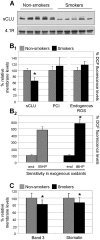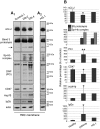Apolipoprotein J/Clusterin is a novel structural component of human erythrocytes and a biomarker of cellular stress and senescence
- PMID: 21998749
- PMCID: PMC3188580
- DOI: 10.1371/journal.pone.0026032
Apolipoprotein J/Clusterin is a novel structural component of human erythrocytes and a biomarker of cellular stress and senescence
Abstract
Background: Secretory Apolipoprotein J/Clusterin (sCLU) is a ubiquitously expressed chaperone that has been functionally implicated in several pathological conditions of increased oxidative injury, including aging. Nevertheless, the biological role of sCLU in red blood cells (RBCs) remained largely unknown. In the current study we identified sCLU as a component of human RBCs and we undertook a detailed analysis of its cellular topology. Moreover, we studied the erythrocytic membrane sCLU content during organismal aging, in conditions of increased organismal stress and accelerated RBCs senescence, as well as during physiological in vivo cellular senescence.
Methodology/principal findings: By using a combination of molecular, biochemical and high resolution microscopical methods we found that sCLU is a novel structural component of RBCs extra- and intracellular plasma membrane and cytosol. We observed that the RBCs membrane-associated sCLU decreases during organismal aging or exposure to acute stress (e.g. smoking), in patients with congenital hemolytic anemia, as well as during RBCs in vivo senescence. In all cases, sCLU reduction paralleled the expression of typical cellular senescence, redox imbalance and erythrophagocytosis markers which are also indicative of the senescence- and oxidative stress-mediated RBCs membrane vesiculation.
Conclusions/significance: We propose that sCLU at the mature RBCs is not a silent remnant of the erythroid precursors, but an active component being functionally implicated in the signalling mechanisms of cellular senescence and oxidative stress-responses in both healthy and diseased organism. The reduced sCLU protein levels in the RBCs membrane following cell exposure to various endogenous or exogenous stressors closely correlates to the levels of cellular senescence and redox imbalance markers, suggesting the usefulness of sCLU as a sensitive biomarker of senescence and cellular stress.
Conflict of interest statement
Figures






Similar articles
-
Apolipoprotein J/clusterin in human erythrocytes is involved in the molecular process of defected material disposal during vesiculation.PLoS One. 2011;6(10):e26033. doi: 10.1371/journal.pone.0026033. Epub 2011 Oct 7. PLoS One. 2011. PMID: 22016805 Free PMC article.
-
ATM regulates insulin-like growth factor 1-secretory clusterin (IGF-1-sCLU) expression that protects cells against senescence.PLoS One. 2014 Jun 17;9(6):e99983. doi: 10.1371/journal.pone.0099983. eCollection 2014. PLoS One. 2014. PMID: 24937130 Free PMC article.
-
The chaperone activity of clusterin is dependent on glycosylation and redox environment.Cell Physiol Biochem. 2014;34(5):1626-39. doi: 10.1159/000366365. Epub 2014 Nov 3. Cell Physiol Biochem. 2014. PMID: 25402950
-
The molecular chaperone apolipoprotein J/clusterin as a sensor of oxidative stress: implications in therapeutic approaches - a mini-review.Gerontology. 2013;59(6):514-23. doi: 10.1159/000351207. Epub 2013 May 15. Gerontology. 2013. PMID: 23689375 Review.
-
The therapeutic and prognostic role of clusterin in diverse musculoskeletal diseases: a mini review.Physiol Res. 2022 Dec 16;71(6):739-747. doi: 10.33549/physiolres.934908. Epub 2022 Oct 13. Physiol Res. 2022. PMID: 36281729 Free PMC article. Review.
Cited by
-
RNA aptamers specific for transmembrane p24 trafficking protein 6 and Clusterin for the targeted delivery of imaging reagents and RNA therapeutics to human β cells.Nat Commun. 2022 Apr 5;13(1):1815. doi: 10.1038/s41467-022-29377-3. Nat Commun. 2022. PMID: 35383192 Free PMC article.
-
Antibodies to Senescent Antigen and C3 Are Not Required for Normal Red Blood Cell Lifespan in a Murine Model.Front Immunol. 2017 Oct 30;8:1425. doi: 10.3389/fimmu.2017.01425. eCollection 2017. Front Immunol. 2017. PMID: 29163500 Free PMC article.
-
The physiological roles of apolipoprotein J/clusterin in metabolic and cardiovascular diseases.Rev Endocr Metab Disord. 2014 Mar;15(1):45-53. doi: 10.1007/s11154-013-9275-3. Rev Endocr Metab Disord. 2014. PMID: 24097125 Review.
-
Protect, repair, destroy or sacrifice: a role of oxidative stress biology in inter-donor variability of blood storage?Blood Transfus. 2019 Jul;17(4):281-288. doi: 10.2450/2019.0072-19. Epub 2019 Jun 6. Blood Transfus. 2019. PMID: 31184577 Free PMC article. Review.
-
Ethyl glucuronide, a marker of alcohol consumption, correlates with metabolic markers of oxidant stress but not with hemolysis in stored red blood cells from healthy blood donors.Transfusion. 2020 Jun;60(6):1183-1196. doi: 10.1111/trf.15811. Epub 2020 May 8. Transfusion. 2020. PMID: 32385922 Free PMC article. Clinical Trial.
References
-
- Olearczyk JJ, Stephenson AH, Lonigro AJ, Sprague RS. NO inhibits signal transduction pathway for ATP release from erythrocytes via its action on heterotrimeric G protein Gi. Am J Physiol Heart Circ Physiol. 2004;287:H748–754. - PubMed
-
- Bosman GJ, Werre JM, Willekens FL, Novotny VM. Erythrocyte aging in vivo and in vitro: structural aspects and implications for transfusion. Transfus Med. 2008;18:335–347. - PubMed
-
- Mohandas N, Groner W. Cell membrane and volume changes during red cell development and aging. Ann N Y Acad Sci. 1989;554:217–224. - PubMed
-
- Kay M. Immunoregulation of cellular life span. Ann N Y Acad Sci. 2005;1057:85–111. - PubMed
Publication types
MeSH terms
Substances
LinkOut - more resources
Full Text Sources
Other Literature Sources
Research Materials

